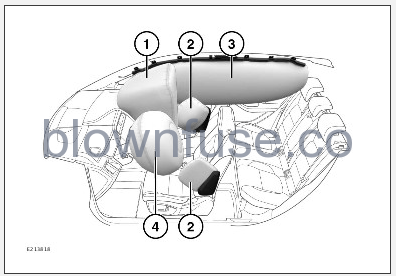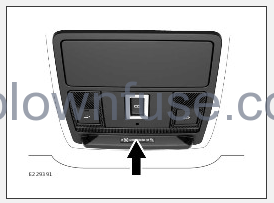 2023 JAGUAR I-PACE AIR BAGS
2023 JAGUAR I-PACE AIR BAGS

AIR BAG SAFETY
Make sure to read and fully understand the relevant warnings before using any of the features in this section. Failure to observe warnings and cautions may result in vehicle damage, injury, or DEATH in the event of an accident.
High speed impacts may cause serious injury or death, irrespective of safety features fitted to a vehicle.
Always wear seat belts, for every journey, no matter how short, in all seating positions. The air bag Supplementary Restraint System (SRS) adds to the overall effectiveness of the seat belts, but it does not replace them.
Always make sure the roof lining and door pillar trims are correctly fitted, in good condition, and free from obstruction.
Always wear correctly positioned seat belts, and sit as far back as practically possible from the air bag. Air bags inflate at high speeds and can cause facial abrasions or other injuries.
Always maintain a gap between the side of the vehicle, and the head and torso to enable unobstructed inflation of the air bags.
AIR BAG OPERATION
Make sure to read and fully understand the relevant warnings before using any of the features in this section. See AIR BAG SAFETY.
The air bag Supplementary Restraint System (SRS) inflates instantaneously, and cannot provide protection in secondary or some other types of impact. Under these circumstances, the only protection is provided by a correctly worn seat belt.
Air bag deployment is dependent on the rate at which the passenger compartment changes velocity following a collision. Circumstances affecting different collisions, vehicle speed, angle of impact, type and size of object hit, etc. vary considerably and affect the rate of vehicle deceleration accordingly.
The air bags and SRS are not designed to operate as a result of:
- Rear impacts.
- Minor front impacts.
- Minor side impacts.
- Heavy braking.
- Driving over bumps and pot holes.
AIR BAG OBSTRUCTION
Make sure to read and fully understand the relevant warnings before using any of the features in this section. See AIR BAG SAFETY.
Never obstruct the operation of the air bags by placing any part of the body or any objects in contact with, or close to, an air bag module. In the event of an accident, any items obstructing the air bag could cause harm to occupants.
Never place objects over or near the air bag on the instrument panel. Objects can cause harm if the vehicle is in a crash severe enough to cause the air bag to inflate.
Unauthorized modifications of the vehicle or parts may invalidate the vehicle’s warranty.
Examples of obstructions include:
- Any part of an occupant’s body in contact with, or close to, an air bag cover.
- Objects placed on, or close to, an air bag cover.
- Clothing, sun screens, or other material hanging from grab handles.
- Clothing, cushions, or other material covering seat-mounted air bags.
- Seat covers which are not approved by the vehicle manufacturer, or specifically designed for use with seat-mounted air bags.
AIR BAG DEPLOYMENT EFFECTS
Make sure to read and fully understand the relevant warnings before using any of the features in this section. See AIR BAG SAFETY.
When the air bag inflates:
A loud noise is emitted. The noise may cause temporary discomfort and loss of hearing.
Some air bag components become very hot. Do not touch the air bag components until they have cooled sufficiently.
- If any of these problems occur, get out of the vehicle as soon as it is safe to do so. If breathing problems persist, seek medical attention.
- After inflation, the front and seat mounted side air bags deflate immediately. Deflation provides a gradual cushioning effect for the occupants and also makes sure the driver’s forward vision is not obscured.
AIR BAG WARNING LAMP
Make sure to read and fully understand the relevant warnings before using any of the features in this section. See AIR BAG SAFETY.
The warning lamp indicates a potential fault with the vehicle restraint system. Never use a child restraint on the front passenger seat if the warning lamp indicates a potential fault with the vehicle restraint system.
The instrument panel displays an illuminated air bag warning lamp as a bulb check when the electrical system is enabled. See AIR BAG (YELLOW).
If any of the following air bag warning lamp conditions occur, the vehicle should be checked by a retailer/authorized repairer immediately.
- Fails to illuminate when the electrical system is enabled.
- Fails to extinguish within 6 seconds of the electrical system is enabled.
- Illuminates at any time, other than during the bulb check, electrical system is enabled.
When the electrical system is enabled, a diagnostic control unit monitors the readiness of the system’s electrical circuits. Elements of the Supplementary Restraint System (SRS) being monitored include:
- SRS warning lamp.
- Rotary coupler.
- Air bag modules.
- Seat belt pre-tensioners.
- Air bag diagnostic control unit.
- Crash and rollover sensors.
- Air bag wiring harness.
- Seat occupancy sensor.
- Front passenger belt tension sensor.
- Air bag status indicator.
- Front seat belt buckle switches.
- Front seat track position sensor.
- Pyrotechnic brake pedal release.
Not all of the SRS Elements listed are fitted to all specifications of vehicle.
AIR BAG SERVICE INFORMATION
Make sure to read and fully understand the relevant warnings before using any of the features in this section. See AIR BAG SAFETY.
Never attempt to service, repair, replace, modify, or tamper with any part of the SRS, or with any wiring or components in the vicinity of the SRS. Doing so may cause the system to trigger or render the system inoperative.
Never use any electrical test equipment or devices in the vicinity of any Supplementary Restraint System (SRS) components or wiring. Doing so may cause the system to trigger or render the system inoperative.
The following operations should only be carried out by a retailer/authorized repairer or a qualified person:
Fitment of electrical, or electronic, equipment and accessories.
Modification to the front or sides of the vehicle’s exterior.
Attachment of accessories to the front or sides of the vehicle.
Note: Always consult a retailer/authorized repairer if:
- An air bag inflates.
- The front or sides of the vehicle are damaged.
- Any part of the air bag SRS shows signs of cracking or damage, including trim covering air bags.
- The amber air bag warning lamp illuminates.
DISABILITY MODIFICATIONS
Make sure to read and fully understand the relevant warnings before using any of the features in this section. See AIR BAG SAFETY.
Occupants with disabilities which may require the vehicle to be modified must contact a retailer/authorized repairer before any modifications are made. Incorrect modifications may result in death or serious injury in the event of an accident.
USA only: If you are considering modifying the vehicle in any way to accommodate a disability, e.g., by altering or adapting the driver’s or passenger’s seat(s) or air bag system, please contact:
Jaguar Land Rover North America LLC
100 Jaguar Land Rover Way
Mahwah, NJ 07495
24/7 Roadside assistance: 1-800-637-6837
General inquiries: 1-800-FIND 4WD
AIR BAG LOCATIONS
Make sure to read and fully understand the relevant warnings before using any of the features in this section. See AIR BAG SAFETY.
National Highway Traffic Safety Administration (NHTSA) recommends a minimum distance of 10in (25cm) between an occupant’s chest and the driver’s air bag module.

- Front passenger’s air bag.
- Front seat side air bags.
- Curtain air bag.
- Driver’s air bag.
The general location of air bags fitted to the vehicle are marked by the word AIR BAG.
FRONT AIR BAGS
Make sure to read and fully understand the relevant warnings before using any of the features in this section. See AIR BAG SAFETY.
The front passenger and driver air bags deploy depending on the severity of the frontal impact. In the case of the driver side air bag it is able to deploy in 2 stages, in lesser impacts full deployment is not required, so the air bag is partially inflated.
SIDE AIR BAGS
Make sure to read and fully understand the relevant warnings before using any of the features in this section. See AIR BAG SAFETY.
The side air bags are designed to protect the thorax region of the torso. In general, the side air bags deploy in the event of a side impact, and only on the side of the impact.
CURTAIN AIR BAGS
Make sure to read and fully understand the relevant warnings before using any of the features in this section. See AIR BAG SAFETY.
The curtain air bags are deployed in side-impact and rollover events, providing greater protection from serious head injuries.
Curtain air bags do not only inflate as a result of side impacts and rollover events. The curtain air bags may deploy in some frontal impacts.
OCCUPANT SENSING
Make sure to read and fully understand the relevant warnings before using any of the features in this section. See AIR BAG SAFETY.
Crash statistics show that children are safest when properly restrained in a child restraint system. Children should be placed in an age and weight-appropriate child restraint system and should be secured in a rear seating position.
Extreme hazard! Never place a rearward-facing child restraint on the front passenger seat. The infant could be seriously injured or killed if the air bag deploys.
For optimum safety, children under the age of 13 should travel in the rear of the vehicle at all times. Front passenger seat travel is not recommended. An inflating air bag could cause injury or death to children traveling in the front passenger seat.
The front passenger seat is fitted with an occupancy sensor system that determines if:
- The seat is unoccupied.
- The seat is occupied by a person or object of low weight, or a child seat.
- The seat is occupied by a heavier person or object.
The system consists of:
- A weight sensing pressure pad fitted under the front passenger seat cushion. The sensor measures downward pressure and weight on the seat cushion.
- A seat belt tension sensor integrated into the anchor point of the front passenger seat belt.
- A control unit fitted under the front passenger seat.
- An air bag status indicator lamp, mounted in the roof console.
Make sure the vehicle’s electrical system is enabled when checking the operational status of the front passenger air bag.

There are three operational states. The operational states are shown in the following table:
| Occupancy status | Passenger air bag status | Status indicator display |
|---|---|---|
| Completely empty. | Deactivated. | PASSENGER AIR BAG OFF * |
| Child restraint, or low weight occupant or object. | Deactivated. | PASSENGER AIR BAG OFF |
| Heavy occupant or object. | Activated. | ON PASSENGER AIR BAG ** |
* If the status lamp shows that the air bag is off with a seated adult in the front passenger seat, contact a retailer/authorized repairer immediately.
** Displays for 60 seconds, followed by no display.
Deactivation of the passenger air bag also deactivates the side air bag on the passenger side.
